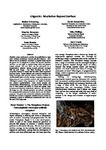Gigantic: Mediation Beyond Surface (Panel)
| dc.contributor.author | Phillips, Mike | |
| dc.contributor.author | Hessels, S | |
| dc.contributor.author | Benayoun, M | |
| dc.contributor.author | Shaw, J | |
| dc.contributor.author | Travis, S | |
| dc.date.accessioned | 2023-02-13T20:12:26Z | |
| dc.date.available | 2023-02-13T20:12:26Z | |
| dc.date.issued | 2016 | |
| dc.identifier.uri | http://hdl.handle.net/10026.1/20321 | |
| dc.description.abstract |
Mediated space continues to redefine its possibilities as large scale surfaces increasingly become playable displays. Now that we can be increasingly immersed in gigantic image spaces the panel will investigate how surface has become frameless and how we can begin to explore image cities and propose imaged planets. The soil itself can be reinvented as a programmable material, leading towards artificial ecologies that are pure design. Our cities buildings are now so completely skinned in display that the entire urban experience becomes media. Smart materials and controlled reactions are being developed that promise massive reactive surfaces in which material behavior is the message. Immersive displays are being removed from scientific contexts with both domes and 360-degree systems being repurposed for digital humanities and creative experimentation. These model projects are fundamentally transdisciplinary, not just in their creation but also in their impact and ability to infect and engage large audiences and transform institutional orthodoxy. We are inside the image now, the ultimate spectacle, and actively exploring how programmable spaces and surfaces can be used for artistic purposes. The panel will consider the aesthetics, technicalities, benefits and concerns of gigantic mediation beyond surface by presenting a group of international practitioners who work in the field of the large scale. | |
| dc.language.iso | en | |
| dc.title | Gigantic: Mediation Beyond Surface (Panel) | |
| dc.type | conference | |
| dc.type | inproceedings | |
| plymouth.date-start | 2016-05-16 | |
| plymouth.date-finish | 2016-05-22 | |
| plymouth.conference-name | 22nd International Symposium on Electronic Art. ISEA2016 香港 Cultural R>evolution | |
| plymouth.organisational-group | /Plymouth | |
| plymouth.organisational-group | /Plymouth/Faculty of Arts, Humanities and Business | |
| plymouth.organisational-group | /Plymouth/Faculty of Arts, Humanities and Business/School of Art, Design and Architecture | |
| plymouth.organisational-group | /Plymouth/REF 2021 Researchers by UoA | |
| plymouth.organisational-group | /Plymouth/REF 2021 Researchers by UoA/UoA32 Art and Design: History, Practice and Theory | |
| plymouth.organisational-group | /Plymouth/Research Groups | |
| plymouth.organisational-group | /Plymouth/Research Groups/Institute of Health and Community | |
| plymouth.organisational-group | /Plymouth/Users by role | |
| plymouth.organisational-group | /Plymouth/Users by role/Academics | |
| dc.publisher.place | Hong Kong | |
| dc.rights.embargoperiod | Not known | |
| rioxxterms.licenseref.uri | http://www.rioxx.net/licenses/all-rights-reserved | |
| rioxxterms.type | Conference Paper/Proceeding/Abstract |


